初中英语语法的一等奖说课稿
仁爱版初中初三英语上册《语法》说课稿

仁爱版初中初三英语上册《语法》说课稿一、教材分析本节课所使用的教材是《仁爱版初中初三英语上册》,在本册教材的内容中,语法部分占据着非常重要的位置。
通过学习语法,学生可以建立对英语语言结构的基本认识,从而提高他们的英语表达能力。
二、教学目标1. 知识目标•了解不同语法知识的基本概念和用法;•掌握一些常用的语法规则和结构;•能够正确地运用语法知识进行句子的构建和变换。
2. 能力目标•培养学生的语言分析和处理能力;•培养学生的语法运用能力;•增强学生的英语交流和表达能力。
3. 情感目标通过本节课的学习,让学生明白语法是学习英语的基础,培养他们对语法规则的兴趣和认识,养成良好的学习习惯和自主学习的能力。
三、教学重难点1. 教学重点让学生掌握基本的英语语法知识并能够运用到实际交流中。
2. 教学难点如何通过简单明了的方式教授语法知识,让学生感兴趣并能够理解并运用到写作和口语中。
四、教学过程1. 导入在导入环节中,可以通过一段有趣的故事或问题引起学生的兴趣。
例如,可以通过一个小故事说课:关于动词时态的故事:在一个小镇的动物园里,动物们都过着快乐的生活。
有一天,一只可爱的小猪跑到了动物园里。
小猪取名为Tom,他非常喜欢和其他动物们一起玩耍。
但是有一天,Tom生病了,他躺在床上无法出去玩耍了,所以他想出一个办法,他学会了利用不同的动词时态来告诉其他动物他曾经做什么。
让我们一起来听听Tom的故事。
2. 学习在学习环节中,可以使用多媒体工具或黑板进行语法知识的介绍和讲解。
可以结合教材中的相关课文和例句进行讲解,让学生了解不同语法规则和结构的用法。
例如,我们可以依次讲解下列内容:- 时态•简单现在时:表示经常性、习惯性的动作或真理。
•现在进行时:表示当前正在发生的动作。
•简单过去时:表示已经发生过、或者过去的动作和状态。
•过去进行时:表示过去某一时刻正在进行的动作。
•简单将来时:表示将要发生的动作或事件。
- 被动语态•被动语态的构成和用法•主动语态与被动语态的对比- 条件句•零条件句•一般条件句•真实条件句•虚拟条件句3. 实践在实践环节中,学生可以通过教材中的相关练习进行巩固和实践,也可以进行一些教师设计的练习和活动。
初中英语一等奖说课稿模板

初中英语一等奖说课稿模板《初中英语一等奖说课稿模板》这是优秀的说课稿文章,希望可以对您的学习工作中带来帮助!1、初中英语一等奖说课稿模板各位老师下午好!今天我说课的内容是初中英语教材八年级Unit 4 T opic 1 Plants and animals are impontant to us一、本话题的分析本话题围绕谈论跟描述自然界的风光动植物及生存资源——---森林跟水引入本话题的主要语法项目:形容词的比较级跟最高级;为今后学习现代科技跟历史遗迹的知识打下基础,同时通过Which do you like better/best?以及Paiwork的反复操练,进一步提高学生,听、说、读、写综合素质能力。
二、教学目标:(1)知识目标:The hens are much/a little smaller than the cons/geese.,The mice are the smallest of them.(2)学习单词:Wolf. bear sheep goose rabbit snake rose nature forest protect land ocean sea能力目标:提高学生,听、说、读、写及知识自学的综合能力。
情感目标:培养学生热爱自然,保护自然的环境意识。
本话题所须课时:4节课。
三、重点与难点:重点:学习形容词的比较级跟最高级的用法以及用简单的英语语句描述跟谈论大自然。
难点:1、多音节形容词的比较级跟最高级以及形容词比较级的不规则变化。
2、谈论地球上水资源跟热带雨林的基本状况,以及它们对于地球上生物的重要性。
教材处理:根据以上对教材的分析,同时针对中国学生学习外语存在一定困难的实际情况。
首先给学生创造外语语言气氛,身临其境地把学生带到所设计的语言情景中,同时激发学生学习兴趣:使学生在参与后一系列活动中,掌握知识。
最后通过做游戏对学生所学知识点进行训练,从而达到巩固知识的目的。
初中英语语法说课稿子
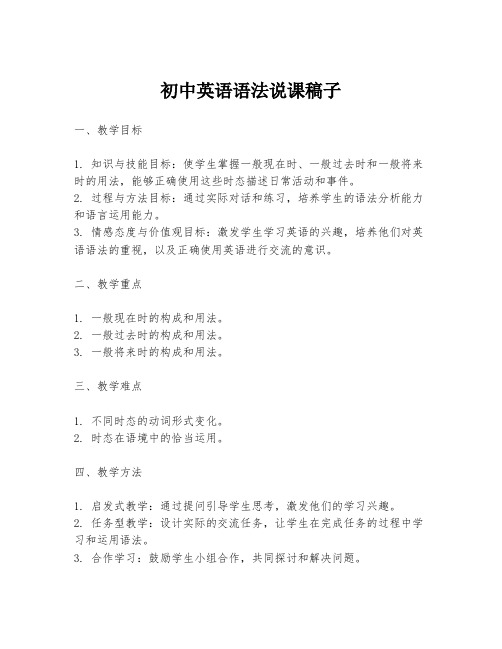
初中英语语法说课稿子一、教学目标1. 知识与技能目标:使学生掌握一般现在时、一般过去时和一般将来时的用法,能够正确使用这些时态描述日常活动和事件。
2. 过程与方法目标:通过实际对话和练习,培养学生的语法分析能力和语言运用能力。
3. 情感态度与价值观目标:激发学生学习英语的兴趣,培养他们对英语语法的重视,以及正确使用英语进行交流的意识。
二、教学重点1. 一般现在时的构成和用法。
2. 一般过去时的构成和用法。
3. 一般将来时的构成和用法。
三、教学难点1. 不同时态的动词形式变化。
2. 时态在语境中的恰当运用。
四、教学方法1. 启发式教学:通过提问引导学生思考,激发他们的学习兴趣。
2. 任务型教学:设计实际的交流任务,让学生在完成任务的过程中学习和运用语法。
3. 合作学习:鼓励学生小组合作,共同探讨和解决问题。
五、教学过程1. 导入(Lead-in):通过展示不同时间的活动图片,引出时态的概念。
2. 新课呈现(Presentation):逐一介绍三种时态的构成和基本用法。
3. 练习(Practice):设计填空、转换句型等练习,巩固学生对时态的理解。
4. 应用(Application):通过角色扮演、情景对话等活动,让学生实际运用所学时态。
5. 总结(Summary):回顾本课所学内容,强调时态的正确使用。
6. 作业(Homework):布置相关的语法练习和写作任务,加深学生对时态的掌握。
六、教学媒体与教具1. 多媒体课件:展示时态的构成和例句。
2. 黑板:用于板书重点内容和练习题。
3. 卡片:用于角色扮演和情景对话活动。
七、板书设计- 一般现在时:构成 + 用法 + 例句- 一般过去时:构成 + 用法 + 例句- 一般将来时:构成 + 用法 + 例句八、教学反思课后,教师应根据学生的表现和作业完成情况,反思教学方法和内容,不断调整和优化教学策略,以提高教学效果。
通过这份说课稿,教师可以系统地准备和实施英语语法教学,确保学生能够全面理解和掌握英语时态的相关知识。
初中的英语一等奖说课稿

初中的英语一等奖说课稿《初中的英语一等奖说课稿》这是优秀的说课稿文章,希望可以对您的学习工作中带来帮助!1、初中的英语一等奖说课稿准备说课稿是很多老师都遇到的事情,好的说课稿是自己优秀的教学理念与教学方法的具体体现。
英语的说课稿也是如此,下面为大家分享了初中的英语说课稿,欢迎借鉴!今天我说课的内容是义务教育课程标准实验教科书七年级英语下册Unit 5 I’m watching TV,下面我将从教学目标,教学重难点,教学工具,教学过程和教学反思五方面进行简要说明。
一、教学目标1.知识目标:1)词汇Clean, on, read, apartment watching TV, eating dinner, cleaning, shopping, reading, doing homework, talking on the phone2)语法现在进行时(Present progressive tense)3)句子What are you doing? I’m watching TV.What’s he doing? He’s doing his homework.What are they doing? They’re cleaning the room.2. 能力目标:学会用英语谈论人们正在做什么(To freely talk about or learn about what they are doing)3. 文化目标:培养用英语获取信息,与人合作的能力。
激发他们学习英语的兴趣和热情,在接近生活常态的交际中乐于模仿,敢于开口,积极参与。
二、教学重难点教学重点基于对教材和教情的分析,我确定本节的教学重点为现在进行时的用法。
To grasp the structure of present continuous tense : What are you doing ? I’m watching TV. What’s she/he doing ? She/he’s ……教学难点①现在进行时中现在分词的结构。
初中七年级英语教案Grammar-省赛一等奖
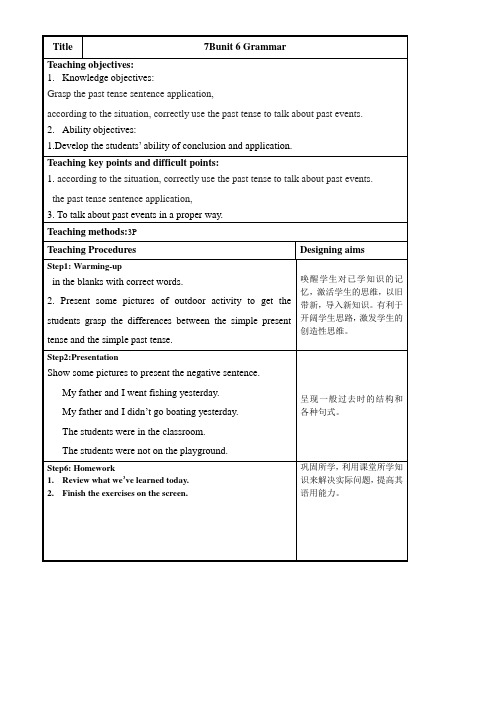
1.Develop the students’ability of conclusion and application.
Teachingkeypoints and difficult points:
1.according to the situation, correctly use the past tense to talk about past events.
巩固所学,利用课堂所学知识来解决实际问题,提高其语用能力。
The students were in the classroom.
The students were not on the playground.
呈现一般过去时的结构和各种句式。
Step6: Homework
1.Review what we’ve learned today.
2.Finish the exercises on the screen.
the past tense sentence application,
3.To talk aboutpast eventsin a proper way.
Teaching methods:3P
Teaching Procedures
Designing aims
Step1:Warming-up
in the blanks with correct words.
Step2:Presentation
Showsome pictures to present the negative sentence.
My father and I went fishing yesterday.
My father and I didn’t go boating yesterday.
初二年级上学期英语的一等奖说课稿

初二年级上学期英语的一等奖说课稿1、初二年级上学期英语的一等奖说课稿一、教材分析(一)教材的地位及作用1、新目标英语教材概述《新目标英语》教材的语言教育理念是:知识用于行动强调“语言应用”,培养“创新、实践能力”,发展“学习策略”。
它采用任务型语言教学(Task-based Language Teaching)模式。
教材中每单元都设计一个或几个与该单元话题有关的任务,让学生在完成任务的过程中,使用英语获取信息,用英语进行交流,培养运用英语解决实际问题的能力。
《新目标英语》有以下几个特色:(一)图文并茂。
翻开课本,你都能够在每一页上看到一幅副充满情趣,幽默生动的画面,令你眼睛一亮。
(二)实用性强。
每个单元的选材都来源于学生的学习和生活,与学生的年龄特征、认知结构、生活经验密切联系。
(三)注重交际。
针对中国学生学英语普遍存在的“聋哑病”,教材设计了大量的听说读写材料。
(四)词汇量大。
第一册有词汇700个左右,第二册约450个,第三册约450个,第四册约400个,第五册约500个,合计2500个。
这一点正好达到《英语课程标准》5级的要求。
2、单元分析及教材处理本课是新目标英语八年级上册第8单元,教材以How was your school trip ? 为中心话题,围绕着描述“过去发生的事情”展开,学习和运用一般过去时态的一般疑问句Did you go/see /buy…? Were there any…?询问过去的事件,让学生学会谈论和分享过去发生的事件。
本课教学内容与学生的实际生活密切相关,易于引发学生运用简单的英语进行交际和交流。
在学习活动中,学生通过交换对过去发生的事情的描述及看法,促进学生之间和师生之间的情感交流,增进情谊。
Section A的主要学习内容是:复习一般过去时态和动词的规则与不规则变化,学习一般过去时态的两种一般疑问句: Did you…? Were there any …?教材安排了许多听,说,读,写的任务活动,我将灵活运用这些活动,将其中的一些活动进行变化或整合,如:1c,2c和3c的Pairwork 活动内容相似,我将把2c和3c整合成一个Interview(采访)的任务活动。
《语法》说课稿范文五篇
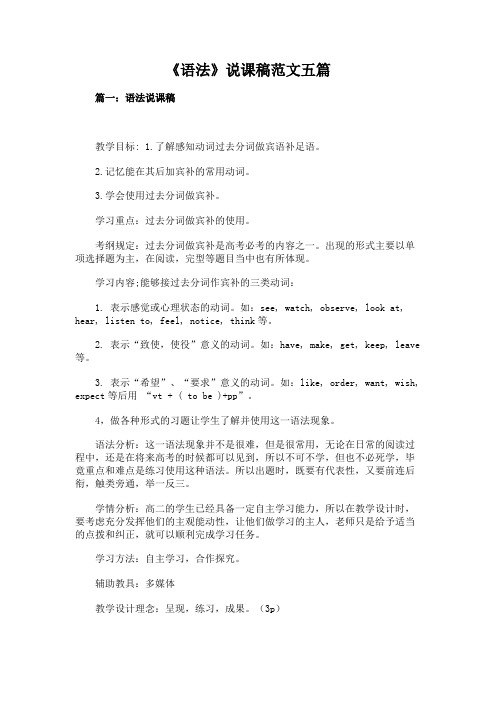
《语法》说课稿范文五篇篇一:语法说课稿教学目标: 1.了解感知动词过去分词做宾语补足语。
2.记忆能在其后加宾补的常用动词。
3.学会使用过去分词做宾补。
学习重点:过去分词做宾补的使用。
考纲规定:过去分词做宾补是高考必考的内容之一。
出现的形式主要以单项选择题为主,在阅读,完型等题目当中也有所体现。
学习内容;能够接过去分词作宾补的三类动词:1. 表示感觉或心理状态的动词。
如:see, watch, observe, look at, hear, listen to, feel, notice, think等。
2. 表示“致使,使役”意义的动词。
如:have, make, get, keep, leave 等。
3. 表示“希望”、“要求”意义的动词。
如:like, order, want, wish, expect等后用“vt + ( to be )+pp”。
4,做各种形式的习题让学生了解并使用这一语法现象。
语法分析:这一语法现象并不是很难,但是很常用,无论在日常的阅读过程中,还是在将来高考的时候都可以见到,所以不可不学,但也不必死学,毕竟重点和难点是练习使用这种语法。
所以出题时,既要有代表性,又要前连后衔,触类旁通,举一反三。
学情分析:高二的学生已经具备一定自主学习能力,所以在教学设计时,要考虑充分发挥他们的主观能动性,让他们做学习的主人,老师只是给予适当的点拨和纠正,就可以顺利完成学习任务。
学习方法:自主学习,合作探究。
辅助教具:多媒体教学设计理念:呈现,练习,成果。
(3p)教学过程:1. 导入。
呈现课文中出现的过去分词作宾补的句子,让学生找出这几个句子的共同点,并归纳语法现象。
2. 过去分词作宾补表示的意义。
组织学生们自己读,自己记,同桌间互相检查,老师抽查。
3.习题练习:1)用所给单词的正确形式填空。
学生两人一组合作完成,各小组派一人起来说出答案。
2)单项选择题,共10个题。
学生四人一组,合作讨论,探究结果,展示汇报,学生评判,陈述理由。
初中英语说课稿一等奖范文三篇

【篇一】初中英语说课稿一等奖ABriefInstructiontothetopicof“WhatshouldIdo?〞Goodafternoon,ladiesandgentlemen.MynameisLiYiCai.IcomefromShangyuanMiddleSchoolinNanj ing.TodayI’mgoingtotalkaboutthetopic〞WhatshouldIdo?〞Iwilldividetheinstructionintosevenparts:theyareTeachingmaterialAnalysis,Teachingaims,Teachingemphasis,Teachingdifficulties,Teachingmethods,TeachingaidsandTeachingproceres.Part1TeachingmaterialanalysisThisperiodisfromUnit3of9AOxfordEnglish.Firstofall,I’dliketotalkaboutmyunderstandingaboutthislesson.WehavelearnedStarsing sinUnit1andColoursandmoodsinUnit2.Wehavealsolearnedhowtowriteaformalrec ommendationletterandhowtowriteareportonthemoodsofpeopleinlasttwounits.T odaywearegoingtolearntwoletterstoafamousyouthworkeraboutMillie’sandSim on’sproblems.SothisunitlinkswithaspecialmeaningofUnit1annit2.Thisperio disthefirstlessonofReading.Themainideaofthetopicishowtoexpresstheirprob lemsandaskforadvice.Wearegoingtolearnthewaystodealwithproblemsandstress infollowinglessons.Sothisperiodisveryimportantinthisunit.Part2Teachingaims1.Aimsoftheknowledge:〔1〕Toknowthespellingofsomewordsansageofsomephrases.〔2〕TolearnsomethingaboutMillie’sandSimon’sproblems.〔3〕TograspthemainideaofReadingansetheinformationtotalktoothersaboutone’sp roblemsandhowtodealwiththem.2.Aimsoftheablilities:〔1〕Toimprovetheabilityofgettinginformationbyreading.〔2〕Toimprovetheabilityofretellingthestory.3.Aimsoftheemotion:〔1〕Tounderstandhowtowriteaboutproblemsandtoexpressfeelings.〔2〕Toaskforadvicetosolvetheproblems.Part3Teachingemphasis1.Tomasterthe‘to’-infinitivesand‘wh-’words ‘to’-infinitives.2.Togettheabilityofgeneralreadingandgettinginformation.Part4Teachingdifficulties1.Torecognizeannderstandvocabularyaboutproblems.2.ToaskforadvicePart5TeachingmethodsInthistopic,Iwillusefive-stepTeachingMethodandTask-basedlanguageTeaching.Idesignsometaskstohelpthestudentslearn.IthinkifIw anttoimprovethestudents’oralEnglish,IshouldgivethemenoughchancestopracticeandIwillusepairwork,groupworktoletthestudentstakeanactivepartinallkindsofactivities.Thatis “Learningbydoing,learningbyusing〞.Letthestudentsbethemastersoftheclassteaching,thus,student-centeredteachingmethodiswellshown.Part6TeachingaidsProjector,slideshow,taperecorderandblackboardPart7TeachingprocereStep Ⅰ.Lead-inThepurposeistoarousethestudents’int erestofstudy.Let’shaveafreetalk.T:Haveyougotproblems?S:Yes.T:Whatisit?S:Eatingtoomuchmakesmeunhealthy.T:Whataboutyou?S:……Step Ⅱ.PresentationThepurposeistodeveloptheskillsofskimmingandhowtogainthemainideaoftheart icles.1.Askstudentstoreadtwolettersandanswerthefollowingquestions:①WhatisMillie’sfavoritehobby?(Painting)②WhatisMillie’sproblem?(Shedoesn’thaveenoughtimeforhobbiesandhomework.)③WhendoesSimonplayfootball?(Afterschooluntillate)④Howdohisparentsfee laboutit?(Theydon’tlikethisandaskhimtogohomebefore6p.m.)2.Askstudentsiftherearewordsthattheydonotknow.Explainsomenewwordsbriefly.deal;choice;complete;refuse;accept;spare;doubt;whether;Step Ⅲ.PracticeThepurposeistodeveloptheskillsofscanningandhowtogainthedetailsfromthear ticles.1.Listentothetapeandanswersomequestionabout“True〞or“False〞.2.Askstudentstoreadthearticlesagainandexplainsomeimportantphrases.Howtosolvetheproblems;handin;ontime;atthemoment;can’tfindanytimeformyhobbies;feelbad;giveup;achieveabalancebetweenthetwo;hearform;makeunhappyStep Ⅳ.RetellingThepurposeistodeveloptheskillsofretellingwiththekeywords1.Askstudentstomakesentenceswithphrasesthatwehavelearned.2.Trytoretelltheoutlineofthearticles.3.Encouragestudentstosaysomethingaboutthemselves.Step Ⅴ.SummaryandhomeworkThepurposeistogivethestudentsaclearideaofhowtoexpresstheirproblemsandre visethearticles.1.Askstudentstorevisethewordsandphrases2.Askstudentstowritealetterabouthimselfafterclass.ringmyteaching,I’lltrymybesttogetmyclassaliveandencouragethestudentstotalkwitheachoth erinEnglish.IthinkthegeneralaimofEnglishteachingistoimprovetheabilityofu singEnglish.AndI’llusethistoguidemyteaching.Thankyou!【篇二】初中英语说课稿一等奖Unit10Wheredidyougoonvacation?Goodmorning,everyone.Iam**fromthe***.IhavetaughtEnglishforovertenyearsandIlikemystu dents.Today,IwilltalkaboutUnit10wheredidyougoonvacation?GoforitJuniorEnglishBook.Thereare6periodstofinishthisunit.Iwilltalkabou tthefirstperiodwiththefollowingparts..I.AnalysisoftheTeachingMaterials. Thetopicofthisunitisthecontinuationofunit9aswellasaboutthepastevents.ByusingtheSimplePasTTense,whichisessentialinjuniorEnglish,studentswilltalkabouttheirpast.Thistopicisabouttheirexperiencesandplacestheyhave visitedontheirvacations.Soithelpsbringbacktheirmemoriesandlearning motivations.II.Students’characteristicAlthoughtheJunior1hasbeenlearningEnglishforalmostayearandarehavingsomebasicknowledge.BecauseoflivinginChinaandsurroundingenvironment,studentsarelearningEnglishimpassivelyandirregularly.ButThejunior1hassho wnedthemselvesverycreative,capableandofplastic ityasthey’redoingsowellinwhatthey’reinterestedinsu chasgamesandCAI.III.TeachingAimsandDemands1.Knowledgeobjectivesa.Toenablethestudentstoread,tospell,tounderstandthevocabularycorrectly.b.Tohelpthestudentsaskandanswerthenewsentencepattern:Wheredidyougoonvacation?2.Abilityobjectives.a.Toimprovethestudents’skillsoflistening,speaking,readingandwriting..b.Toencouragethestudentstocommunicatewithothersuningthenewsentencepatte rn.3.Emotionobjectivesa.TotraintheSstocooperatewellingroupsandinpairs.b.TobeinterestedincommunicatinginEnglish.IV.TeachingKeyPoints1.KeyvocabularyNewYorkCitycampsummercampmuseum2.KeystructuresWheredidyougoonvacation?Iwentto…V.TeachingDifficultyLearnthekeystructuresVI.TeachingMethods1.Task-basedmethodThat’stosayI’llletthestudentsfinish1listeningtaskandmakeshortdialogue salongwiththeactionstohelpthestudentsgetabetterunderstandingofthekeystructures.2 municationmethodI’llsetupadreamandaskstudentstopretentthemselvesasreporters.Thisway,thestudentscansayfreelyandneedn’ttoworryaboutmakingmistakes.VII.LearningMethods1.Listening—speakingmethod2 municativestrategyWeallknowthatthebestwaystolearnEnglishwellaretoimitate,topractice,tolisten,tospeakandtocommunicatemoreconstantly.VIII.TeachingAidsInthislesson,theCAI,cassette,ataperecorderwillbeused.X.TeachingProcereI’llmainlytalkaboutthispart.Itconsists of5steps.Step1Warm–upandreview1.MakeafreetalkbetweenT-S.Whatdidyoudoyesterday?Andwhatdidyourbestfrienddoyesterday?2.WritedownthepasttensesoftheverbsthatIshowinCAI.Purpose:thisstepisinordertoreviewwhatthestudentshavelearntinUnit9.Thatway,Ica nleadthemintothenewlessonsmoothly.IthinkIt’susualbutpratical.Step2Presentation1.Learnthenewwordsandexpressionsa.lead—in:askstudentssomequestions:Didyoudreamlastnight?Whatdidyoudream?WheredidIgoonvacationinmydream?b.CAIshowsmanypicturesofmydream,whicharealsotheactivitiesin1a.c.Askstudentstoreadandspellthenewphrases.d.Do1a.Matchtheactivitieswiththepictures(a—g).e.Playaguessinggame:Iwillshowsomejigsawsofeachpictureandhavethestudentstoguess.Iwillpraiset hestudentwhoanswersmorequickly.Purpose:Iputthevocabularylearningintoadreaminordertopromptthemtofinditveryinter estingtolearnEnglish..ByCAI,studentscanmatchthevocabularywiththerealthingsdirectlyandmasterthemeasi ly.Step3Listeningpracticea.Tellthestudentstolistentothetapeandnumberthepeople(1—5)inthepicture.b.Playtherecorderforthefirsttime,andthenchecktheanswers.c.Playtherecorderagain,studentsimitatetheconversationsandfillintheblanks.Payattentiontotheirpr onunciationandintonation.Purpose:thisisabasicandnecessarystep,whichdevelopsthestudents’skillsoflistening,readingandwriting.Step4Pairworka.T—S:wheredidTinagoonvacation?Shewenttothemountains.Purpose:“Task-based〞teachingmethodisusedheretodevelopthestudents’abilityofcommunicationandtheirabilityofco-operationwillbewelltrained.Thisstepprovidesguidedoralpracticeusingtheta rgetlanguagetoconsolidatethekeystructureandItcandevelopstudents’skillo fspeakingandsenseoflanguage.Step5ProctionHavestudentspretenttobereporterstointerviewanyonetheywanttoaskaboutthei rvacation.Purpose:Afterlearning1a—1c,it’stimetoextendwhattheylearntjustnowandgivethestudentsafreespacetosho wtheirabilities.Withtherealsituations,studentswillfeeleasyandsuccessfulringthispart.Bywayofcommunication,thestudentswillunderstandhowtousethekeystructurebetterandconsolidatethe knowledgefirmly.PartXIHomeworkDoasurveyandwriteareportabouttheclassmates’vocation.Purpose:Ithinkhomeworkissoimportantthatthestudentscanspeakenglishasmuchastheyca ninclassoraf terclass.Isetthisstepinordertopracticestudents’skillsoflis tening,speakingandwriting.BlackboardDesign【篇三】初中英语说课稿一等奖Goodmorning/afternoon,mydearjudges.I’mNo.X.It’smygreathonortobeheretosharemyteachingdesignw itheveryone.Mytopicishowoftendoyouexercise?Listeningandspeakingpart.Mypresentationconsistsoftheanalysisofthefollow ingparts:theteachingmaterial,students,teachingaims,keyanddifficultpoints,teachingmethodsandaids,teachingproceresandtheblackboarddesign.1.AnalysisoftheteachingmaterialFirst,l et’stalkabouttheanalysisoftheteachingmaterial.Thislessonischosenfromt hefirstbookofPEPEnglish,Grade8,Unit2.Itisalisteningandspeakinglesson.Afterthislesson,studentswillknowhowtoexpresshowoftentheydosomethingandtheirfavoriteacti vity.What’smore,theirconfidenceandspeakingabilitywillbeimproved.2.AnalysisofthestudentsThen,itcomestotheanalysisofstudents.TheyareinGrade8andhavelearnedEnglishfors everalyears,thereforetheyhavesomebasicknowledgeaboutthesentencepattern.However,theirspeakingEnglisharenotsowell.Soteachersshouldcreatechancesforthemto practicetheiroralEnglishasmuchaspossible.3.AnalysisoftheteachingaimsAccordingtotheNewCurriculumStandardforEnglish,Isetthefollowingthreeaims:Knowledgeaims:Studentscanmastertheusageofthesentencepattern“Howoftendoyou…?〞and“What’syourfavorite…?〞Studentscanthoroughlyunderstandthemeaningofonce,twice,threetimes,etc.Abilityaims:Studentscanusethesentencepattern“Howoftendoyou…?〞and“What’syourfavorite…?〞intheirconversation.Studentscanimprovetheirspeakingabilitybypairworkandroleplay.Emotionalaims:Studentswillknowhowtoexpresshowtoexpresshowoftentheydosomethingandtheir favoriteactivity.4.AnalysisofthekeyanddifficultpointsThenletmetalkaboutthekey&difficultpoints:studentscanproperlyusethesentencepattern“Howoftendoyou…?〞and“What’syourfavorite…?〞andthephrasessuchastwiceaweek,gotothemovies,etc.5.AnalysisofteachingmethodsandteachingaidsAsfortheteachingmethodsandteachingaids,Iwillmainlyusecommunicativelanguageteachingmethodandtask-basedteachingmethod,aswellaspicturesandmultimedia.6.AnalysisoftheteachingproceresNow,itcomestothemostimportantpart:theanalysisoftheteachingproceres.Iwillfinishthislessoninthefollowingste ps.Step1:warm-up.Inthispart,Iwillfirstsayhellotoeveryoneandthenshowsomepictures,askthemquestions,〞Canyoudescribewhatishappeninginthepicture?〞andleadinthetopicoftoday’slesson---Howoftendoyouexercise?Picturesareusefultoolsforattractingstudents’attenti onanddescribingthen ewwordsandphrases.Byusingpicturesandaskingquestions,Icaneasilyattractstudents’attentionandleadinthetopicofthislesson.Step2:pre-listening.Inthispart,studentswilllearnsomenewphrases:readEnglishbooks,usetheInternet,gotothemovies.Byshowingpicturesansingthesentencepattern“Howoftendoyou…〞withthesenewphrases,studentscanmasterthepronunciationandmeaningofthesenewphrases,aswellasthesentencepattern,thuscreateabetterfoundationforthenextstep---while-listening.Step3:while-listening.Inthispart,studentswilllistentothetapeforthreetimesaltogether.Forthefirsttime,it’sextensive-listening.Studentswillanswerthequestion:Howoftendoyouexercise?Bydoingso,theycanmasterthegeneraltopicofthistext.Then,itcomestotheintensive-listening:afterthesecondtime,theywilldoamatchexercise.Bydoingso,theirlogicalabilitycanbestrengthened.Andforthethirdtime,theywillbeaskedtofillinthechart.Bydoingso,theycanbemorefamiliarwiththenewwordsandphrases.Aftertheseactivities,students’listeningabilityandtheirlogicalthinking abilitywillbeimproved.Step4:post-listening.Inthispart,studentswilldosomepairworkandroleplaytostrengthentheirunderstandingofth islisteningmaterialandtheiroralEnglish.Step5:summaryandhomework.Inthispart,Iwillaskastudenttohelpussummarizewhatwehavelearnedtodaysothatstudentsca ngraspthemaintargetofthislesson.ThenIwillleavethematasktodeepenwhatweha velearnedtodaybymakinganewconversationwiththesentencepatterninthisliste ningmaterial.Bydoingso,studentscanmastertheusageofthesentencepattern.7.AnalysisoftheblackboardDesignThelastpartofmyteachingplanistheblackboarddesign.Itisasfollows:Itissimplebutclear.Studentscaneasilygetthemainpointsofthislesson.That’sallformypresentation.Thankyou.。
初中英语语法课说课稿

初中英语语法课说课稿初中英语语法课是英语教学中的重要组成部分,它不仅帮助学生掌握语言的基本规则,而且能够提高学生的语言表达能力和逻辑思考能力。
以下是一节初中英语语法课的说课稿:# 课程目标1. 使学生能够理解并运用一般现在时态的构成和用法。
2. 帮助学生区分一般现在时态与其他时态的区别。
3. 通过练习,提高学生运用一般现在时态进行口头和书面表达的能力。
# 教学重点- 一般现在时态的构成。
- 一般现在时态的用法,包括陈述句、一般疑问句和特殊疑问句。
# 教学难点- 一般现在时态在不同主语下的动词变化。
- 正确使用一般现在时态表达客观事实、习惯和普遍真理。
# 教学方法- 启发式教学,通过提问引导学生思考。
- 互动式教学,鼓励学生参与课堂讨论和练习。
- 任务型教学,设计相关的语言使用任务,让学生在实践中学习。
# 教学过程导入阶段1. 通过展示一些日常活动的照片或视频,引入一般现在时态的概念。
2. 提问学生关于照片中的活动,引导学生用一般现在时态回答。
呈现阶段1. 明确一般现在时态的定义和构成,特别是第三人称单数动词的变化规则。
2. 展示一般现在时态的肯定句、否定句和疑问句的句型结构。
练习阶段1. 组织学生进行小组练习,转换句子时态,从过去时或将来时转换为一般现在时。
2. 进行角色扮演,让学生在特定情境下使用一般现在时态进行对话。
应用阶段1. 设计一个写作任务,要求学生描述自己的日常生活,使用一般现在时态。
2. 进行课堂展示,学生分享自己的写作,并接受同伴的评价。
总结阶段1. 总结一般现在时态的用法和规则。
2. 强调一般现在时态在描述客观事实、习惯和普遍真理中的重要性。
作业布置1. 完成一篇短文,描述一个熟悉的人的日常活动,要求使用一般现在时态。
2. 准备几个一般现在时态的疑问句,下节课进行问答练习。
通过这样的教学设计,学生不仅能够理解一般现在时态的语法规则,还能够在实际语境中灵活运用,从而提高英语语言运用能力。
七年级英语语法复习省公开课获奖课件说课比赛一等奖课件

人称代词和物主代词
• 一、人称代词 • 表达“我”、“你”、“他”、“她”、“它”、“我们”、
“你们”、“他们”旳词,叫做人称代词。 • 人称代词有人称、数和格旳变化,见下表:
人称代词主格:作主语,表达谁怎么样了、干什么了。 Eg. I am a teacher. You are student. He is a student, too. We/You/They are students. 人称代词宾格:作宾语,表达动作行为旳对象。 Eg. Give it to me. Don’t look at him.
七年级英语语法总复习
一、 要点语法 1. 动词be(am,is,are)旳使用方法:
be动词涉及“am”, “is”, “are”三种形式。 ①第一人称单数(I)配合am来用。句型解析析:I am+… ②第二人称(You)配合are使用。句型解析:You are+… ③第三人称单数(He or She or It)配合is使用。句型解析: She(He, It) is +…… ④人称复数 (we /you/they)配合are使用。句型解析: We (You, They) are +…… 例句: We are in Class 5,Grade 7.
3、“助动词(do, does, did)+ 主语 + 行为动词” 构造
— Do you like swimming ? 你喜欢游泳吗? — No, I don`t . 不,我不喜欢。
肯定句改一般疑问句旳措施
三步法: 1. 有be动词/情态动词: be动词/情态动词提到句首,其他照抄,(some改成 any,my改成your)句末用问号。 2. 无be动词/情态动词: 在句首加Do/Does/Did,其他照抄,(some改成any, my改成your,I 改成you)句末用问号。 3. 加Does、did 旳句子注意,句子动词要变成原形。
江苏初中英语一等奖说课稿
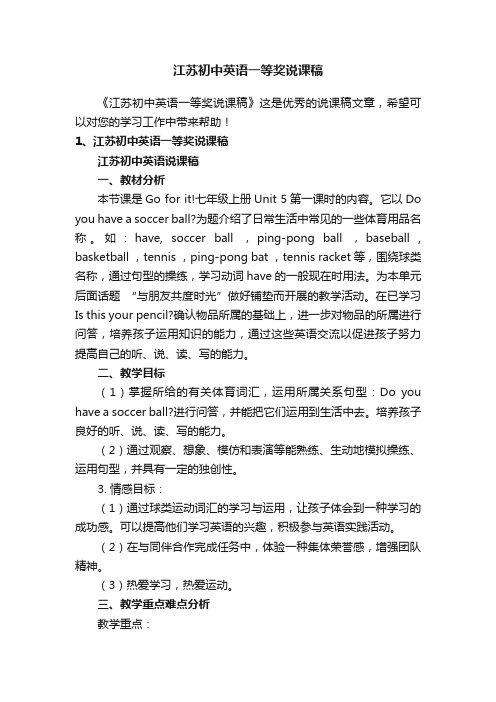
江苏初中英语一等奖说课稿《江苏初中英语一等奖说课稿》这是优秀的说课稿文章,希望可以对您的学习工作中带来帮助!1、江苏初中英语一等奖说课稿江苏初中英语说课稿一、教材分析本节课是Go for it!七年级上册Unit 5第一课时的内容。
它以Do you have a soccer ball?为题介绍了日常生活中常见的一些体育用品名称。
如:have, soccer ball ,ping-pong ball ,baseball , basketball ,tennis ,ping-pong bat ,tennis racket等,围绕球类名称,通过句型的操练,学习动词have的一般现在时用法。
为本单元后面话题“与朋友共度时光”做好铺垫而开展的教学活动。
在已学习Is this your pencil?确认物品所属的基础上,进一步对物品的所属进行问答,培养孩子运用知识的能力,通过这些英语交流以促进孩子努力提高自己的听、说、读、写的能力。
二、教学目标(1)掌握所给的有关体育词汇,运用所属关系句型:Do you have a soccer ball?进行问答,并能把它们运用到生活中去。
培养孩子良好的听、说、读、写的能力。
(2)通过观察、想象、模仿和表演等能熟练、生动地模拟操练、运用句型,并具有一定的独创性。
3. 情感目标:(1)通过球类运动词汇的学习与运用,让孩子体会到一种学习的成功感。
可以提高他们学习英语的兴趣,积极参与英语实践活动。
(2)在与同伴合作完成任务中,体验一种集体荣誉感,增强团队精神。
(3)热爱学习,热爱运动。
三、教学重点难点分析教学重点:1.词汇:have, soccer ball ,ping-pong ball ,basketball baseball ,tennis ,ping-pong bat ,tennis racket.2.句型:I have a/an… I don’t have a/an…A: Do you have a /an…?B: Yes,I do./ No,I don’t.A: Do they/… have a /an…?B: Yes,they do./ No,they don’t.教学难点:1.运用助动词do。
初中英语语法说课稿模板

初中英语语法说课稿模板尊敬的各位老师,大家好。
今天我将为大家说课,主题是初中英语语法教学。
本节课我们将重点探讨如何有效地教授和学习英语语法。
一、教学目标本节课的教学目标是让学生掌握现在进行时态的构成和用法,能够正确地使用现在进行时描述正在进行的动作或状态。
二、教学重点1. 现在进行时态的构成:be动词+动词的现在分词形式。
2. 不同人称的be动词形式:I用am,you用are,he/she/it用is,we/they用are。
3. 动词现在分词的构成方法:一般动词后加-ing。
三、教学难点1. 正确区分现在进行时态和其他时态,如一般现在时和一般过去时。
2. 动词现在分词的不规则变化。
四、教学方法1. 引导式教学:通过提问引导学生思考,激发学生学习兴趣。
2. 互动式教学:通过小组讨论和角色扮演,让学生在实际语境中运用语法知识。
3. 练习式教学:通过大量的练习题,巩固学生的语法知识。
五、教学过程1. 导入(Lead-in):通过展示图片或视频,引出现在进行时态的概念。
2. 新课呈现(Presentation):介绍现在进行时态的构成和用法,并通过例句进行展示。
3. 练习(Practice):设计不同类型的练习题,让学生在练习中掌握语法点。
4. 应用(Application):通过角色扮演或情景对话,让学生在实际语境中运用现在进行时态。
5. 总结(Summary):回顾本节课的语法点,强调重点和难点。
六、作业布置1. 完成课后练习题,巩固现在进行时态的用法。
2. 准备一个关于自己正在做的事情的简短口头报告,下节课进行分享。
七、教学反思在教学过程中,要注意观察学生的反馈,及时调整教学方法,确保每个学生都能跟上课程进度。
同时,要鼓励学生多问问题,培养他们的批判性思维能力。
通过本节课的学习,学生将能够更深入地理解现在进行时态,并能够在实际交流中灵活运用。
谢谢大家的聆听,期待与大家共同探讨更多的教学方法。
初中英语语法说课稿(大全五篇)
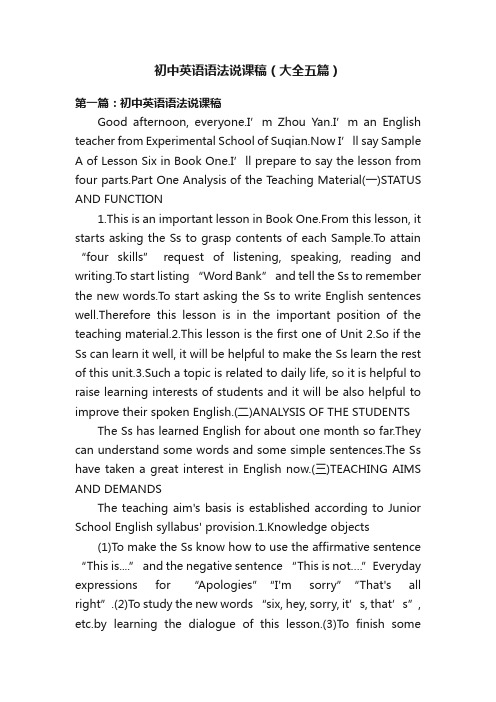
初中英语语法说课稿(大全五篇)第一篇:初中英语语法说课稿Good afternoon, everyone.I’m Zhou Yan.I’m an English teacher from Experimental School of Suqian.Now I’ll say Sample A of Lesson Six in Book One.I’ll prepare to say the lesson from four parts.Part One Analysis of the T eaching Material(一)STATUS AND FUNCTION1.This is an important lesson in Book One.From this lesson, it starts asking the Ss to grasp contents of each Sample.T o attain “four skills” request of listening, speaking, reading and writing.T o start listing “Word Bank” and tell the Ss to remember the new words.To start asking the Ss to write English sentences well.Therefore this lesson is in the important position of the teaching material.2.This lesson is the first one of Unit 2.So if the Ss can learn it well, it will be helpful to make the Ss learn the rest of this unit.3.Such a topic is related to daily life, so it is helpful to raise learning interests of students and it will be also helpful to improve their spoken English.(二)ANALYSIS OF THE STUDENTS The Ss has learned English for about one month so far.They can understand some words and some simple sentences.The Ss have taken a great interest in English now.(三)TEACHING AIMS AND DEMANDSThe teaching aim's basis is established according to Junior School English syllabus' provision.1.Knowledge objects(1)To make the Ss know how to use the affirmative sentence “This is....” and the negative sentence “This is not….”Everyday expressions for “Apologies”“I'm sorry”“That's all right”.(2)To study the new words “six, hey, sorry, it’s, that’s”, etc.by learning the dialogue of this lesson.(3)To finish someexercises.2.Ability objects(1)To develop the Ss’ abilities of listening, speaking, reading and writing.(2)To train the Ss’ ability of working in pairs.(3)To develop the Ss’ abilities of communication by learning the useful structures.3.Moral objects(1)To enable the Ss to be polite and love life.(2)To enable the Ss to look after their things well.(四)TEACHING KEY AND DIFFICULT POINTSThe teaching key and difficult points’ basis is established according to Sample A of Lesson Six in the teaching material's position and function.1.Key points:(1).To help the Ss to communicate with each other.(2).To enable the Ss to study in groups and co-operate skillfully.(3).T o develop the Ss’ interest in English.2.Difficult points:(1)How to make dialogues and act them out.(2)How to write the right whole sentences.(五)TEACHING AIDSMulti-media computer, Tape recorder, Software: Powerpoint or Authorware, school things and so on.They will be needed in this lesson.Part Two The T eaching Methods municative teaching method 2.Audio-visual teaching method 3.Task-based” teaching methodAs we all know: the main instructional aims of learning English in the Middle School is to cultivate students’ abilities of listening, speaking, reading, writing and their good sense of the English language.So in this lesson I’ll mainly use “Communicative” teaching method, “Audio-visual” teaching method an d “Task-based” teaching method.That is to say, I’ll let the Ss to get a better understanding of the key structure of the dialogue.I’ll give the Ss some tasks and arrange five kinds of activities: talking, guessing games, watching CAI, acting outSample A and having a competition.T eaching special features To use these methods are helpful to develop the Ss’ thought.Part Three STUDYING WAYS1.Teach the Ss how to be successful language learners.2.Let the Ss pass “Observation—Imitation—Practice ” to study language.3.Teach the Ss how to master dialogues and how to communicate with others.Teaching special features:Let the Ss communicate with each other and adopt competition methods to develop the Ss’ keen interest in English.Part Four T eaching ProcedureI’ll finish this lesson in four steps.First I’ll divide the Ss into four groups and bring a competition into the class.At last let’s see which group is the winner.Step1 Warm-up1.Free talk between T and Ss.Such as: Hi, I’m....What’s your name? This is ….How do you do? Who is he/she? How are you? Who can count from 1to 5? What’s this in English? etc.2.A game: Ask the Ss to give T some school things.For example: T: Give me your book.(ruler, box, pen, table, knife, etc.)T: This is your book.This is not my book.It’s your book.etc.In this course I’ll ask them to make a dialogue group by group without repetition.Find out which group will make the most dialogues.Purpose of my designing: I think it is important to form a better English learning surrounding for the Ss by imitating and at the same time it is necessary to provide situations to review learned knowledge.Step2.PresentationThis course is very important.I’ll mainly talk about this step.I’ll use CAI to present the whole dialogue.Arrange some situations to help Ss understand Sample A.First scene: There is a bag on the floor.B is picking it up and get ready to leave.Now A is talking with B.A: Hi, B.How are you today? B: I’m fine, thankyou.And you? A: I’m fine, too.Oh, this is my bag.B: No, this is not your bag.It’s my bag.A:(Look closely)Oh, I’m sorry.B: That’s all right.(At the same time, C is running up and hitting A.)C: Oh, I’m sorry.A: That’s OK.I’ll write the key points on the Bb while they are watching.After watching, I’ll teach them to read the words and sentences on the Bb.Make sure they can read them well.Purpose of my designing: T o present Sample A by CAI is much easier for the Ss to learn and grasp the meanings.CAI can provide a real situation with its sound and picture and it makes the relationships between the Ss better.Step3.Practice First play the tape recorder.Let the Ss listen and imitate the dialogue.Pay attention to their pronunciation and intonation.In this step the Ss are required to practise the Sample in pairs by reading the dialogue aloud.This step is employed to make the Ss grasp the Sample.At last I’ll ask the Ss to think hard and act it out with a partner according to Sample A.Then find out which group will act it out well.I’ll give them red stars.Purpose of my designing: This step is employed to make the Ss get the general idea of the dialogue as a whole one.At the same time let the Ss have a chance to practise their listening and spoken ability.Step4.ProductionIn this step I’ll give the Ss a free space to show their abilities.Second scene: The Ss are having a picnic.It’s hot and they take off their coats and put them together.They are singing and dancing, laughing and chatting.After the picnic, they begin to look for their coats.D and E are talking.F and G are talking.etc.After watching, I’ll give the Ss some tasks to make similar dialogues without repetition and find out which group will make more dialogues.Purpose of my designing: “Task-based” teaching method is used here to develop the Ss’ ability ofcommunication and also their ability of co-operation will be well trained.Tell the Ss we should be polite and take good care of our things.We should love our life.I think proper competition can arouse the Ss’ interest in English learning.If the Ss can finish this task well, they will benefit a lot in their spoken English.2.Skill 1 Model 1.I’ll ask four Ss of the groups to write these sentences on the Bb in the four lines.Then check their handwriting, correct their mistakes.Find out who will write well and whose handing is the best.3.Finish the Ss’ workbook.Purpose of my designing: To check the knowledge Ss have learned in this lesson.Step5.Homework:(1)Recite the words as many as possible after class.(2)Make a dialogue according to Sample A and write it in the exercise book.Purpose of my designing: I think homework is so important that the Ss should speak English as much as they can in class or after class.It is necessary for the Ss to do some extensive exercises after class to consolidate the knowledge they learned.Blackboard DesignLesson Six S ample ASix This is my….hey This is not your....sorry It’s my....Picture it’s=it is Oh, I’m sorry.that’s=that is That’s all right/OK.第二篇:关于初中英语语法的说课稿语法是英语学习总非常重要的内容,关于初中英语语法的说课稿有哪些?以下是小编为您整理的相关资料,欢迎阅读!一、教学目标学习反意疑问句二、教学重点通过教学让学生掌握反意疑问句的基本句型结构和回答。
初中英语优秀说课稿语法
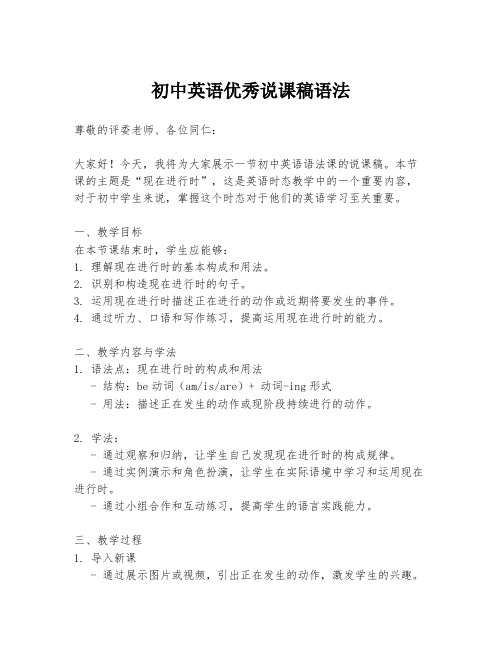
初中英语优秀说课稿语法尊敬的评委老师、各位同仁:大家好!今天,我将为大家展示一节初中英语语法课的说课稿。
本节课的主题是“现在进行时”,这是英语时态教学中的一个重要内容,对于初中学生来说,掌握这个时态对于他们的英语学习至关重要。
一、教学目标在本节课结束时,学生应能够:1. 理解现在进行时的基本构成和用法。
2. 识别和构造现在进行时的句子。
3. 运用现在进行时描述正在进行的动作或近期将要发生的事件。
4. 通过听力、口语和写作练习,提高运用现在进行时的能力。
二、教学内容与学法1. 语法点:现在进行时的构成和用法- 结构:be动词(am/is/are)+ 动词-ing形式- 用法:描述正在发生的动作或现阶段持续进行的动作。
2. 学法:- 通过观察和归纳,让学生自己发现现在进行时的构成规律。
- 通过实例演示和角色扮演,让学生在实际语境中学习和运用现在进行时。
- 通过小组合作和互动练习,提高学生的语言实践能力。
三、教学过程1. 导入新课- 通过展示图片或视频,引出正在发生的动作,激发学生的兴趣。
- 提问学生正在做什么,引导学生用英语表达。
2. 呈现和讲解- 板书现在进行时的结构,并用实例句子进行讲解。
- 通过比较一般现在时和现在进行时,让学生理解两者的区别。
3. 练习与应用- 让学生通过填空练习,巩固现在进行时的构成。
- 组织角色扮演活动,让学生在模拟情景中运用现在进行时。
- 安排小组讨论,让学生分享他们正在做的事情,并用现在进行时进行描述。
4. 总结与作业- 总结现在进行时的用法和注意事项。
- 布置相关练习题和日记写作,要求学生用现在进行时记录自己的一天。
四、教学评价1. 过程评价:通过观察学生的参与度和练习完成情况,评价学生对现在进行时的掌握程度。
2. 结果评价:通过课后作业和测试,评估学生对现在进行时的运用能力。
五、教学反思本节课结束后,我将根据学生的反馈和学习效果,对教学方法和内容进行反思和调整,以确保教学目标的实现。
初一英语一等奖说课稿

初一英语一等奖说课稿《初一英语一等奖说课稿》这是优秀的说课稿文章,希望可以对您的学习工作中带来帮助!1、初一英语一等奖说课稿所谓说课,就是教师备课之后讲课之前(或者在讲课之后)把教材、教法、学法、授课程序等方面的思路、教学设计、|板书设计及其依据面对面地对同行(学生科教师)或其他听众作全面讲述的一项教研活动或交流活动。
以下是初一英语说课稿范文,欢迎阅读。
一、说教材1、教学内容:义务教育课程标准实验教科书《英语》七年级上册第二单元《Is this your pencil》第一课时,P7,P8。
2、在教材中的地位:本课在教材中不可忽视,起到承上启下的作用。
预备单元已学过What’s this in English?及其回答,现在进一步用What’s that in English?及其回答,接着用这个句型介绍出本课中的大量词汇。
通过词汇进而学习Is this /that your pencil?及其肯定、否定回答。
在这个过程中充分复习并运用my,your,his,her,等形容词性物主代词。
指示代词this,that及这一句型为第三单元及以后学习一般疑问句打下基础。
并且这一课时的教材在原来的基础上使学生更明白英语的学习是在相互交流中有趣地进行,听、说、读、写、用就是学习的过程。
为学生学习以后的内容打下坚实的心理、方法和知识的基础。
3、教学目标⑴知识目标:通过演示及情景教学法,使用句型What’s this /that in English?It’s a book。
使学生掌握重点词汇:pen, pencil, pencil case,pencil sharpener, book, eraser,ruler, backpack, dictionary 等,并且学会对物品的所属进行提问、回答,在问答中会熟练运用my,your,his,her等形容词性物主代词,即:Is this/that my/your/his/her pen? Yes, it is。
初中英语一等奖教学设计3篇

第1篇初中英语一等奖教学设计作为一名专为他人授业解惑的人民教师,常常需要准备教案,教案是教学活动的总的组织纲领和行动方案。
那要怎么写好教案呢?下面是小编整理的初中英语万能教案,供大家参考借鉴,希望可以帮助到有需要的朋友。
一、知识与技能1、掌握重点句型:How was your vacation?Where did you go? Did you go out with anyone?2、理解并掌握几个不定代词:anyone, everyone, something, anything, everything, nothing的用法。
3、熟练运用句型:Did you …?二、过程与方法学生通过上一节课的学习,对where引导的过去时态的特殊疑问句已经掌握,能自然地与本课知识相衔接。
让学生回忆他们的假期情况,引出一般过去时态的`句型,并且进行大量练习。
采用学生提出问题,学生解决问题,借助多媒体来提高学生的主动性。
三、情感、态度与价值观教育学生渗透合作精神和社会公德意识。
教学重点掌握句型:Where did you go on vacation? Did you go out with anyone? Did you buy anything? Did you visit anyone?教学难点能用句型Did you …?提出尽可能多的有关过去假期的问题。
教法导航创设情境,让学生自己总结规律,思考,讨论,最后得出结论。
创设英语语言氛围,使学生能较快地融入到英语语言学习的情景中来。
学法导航自主学习,独立思考,小组讨论,同桌合作,完成学习任务。
教学准备视频,图片,多媒体。
教学过程Step 1 GreetingsGreet the class as usual、Step 2 RevisionAsk the students to look at the picture on Page 1 and make conversations, using the sentence pattern: —Where did you go on vacation? —I went to the mountains、—Did you go with anyone? —Yes, I did、/ No, I didn’t、Step 3 Role playThe teacher acts as Rick and ask a student to act as Helen and practice the dialogue of 2d on Page 2、Then ask the students to practice in pairs and finally ask two or three pairs to act it out、Step 4 Grammar FocusReview the grammar box、Ask students to say the questions and answers、Review the difference between regular –ed past tense verbs (stay –stayed, visit-visited) and irregular past tense verbs (go –went, buy-bought)、Then get the students to ask and answer the questions and answers in pairs、Step 5 GameAsk one student to act as the teacher and ask some individual students questions、Get as many students as possible to be the teacher、Then ask the students to pay attention to the words: no one, anyone, everyone, something, nothing, anything、Step 6 Practice3a Fill in the blanks with the words in the box and practice the conversation、3b Fill in the blanks in the e-mail mestudentsage with the words in the box、After checking the answers, get the students to read them aloud、Step 7 Group workMake a survey、Ask the students to make a survey by asking the questions about their last vacation: Did you eat anything at a reastaurant? Did you read anything interesting? …、Make sure the students practice the dialogues again and again and write down the results in the form、Then ask some students to report their results、Step 8 HomeworkAsk your classmates as many questions about their last vacation as possible 第2篇初中英语一等奖教学设计作为一名为他人授业解惑的教育工作者,总不可避免地需要编写教案,教案是教材及大纲与课堂教学的纽带和桥梁。
- 1、下载文档前请自行甄别文档内容的完整性,平台不提供额外的编辑、内容补充、找答案等附加服务。
- 2、"仅部分预览"的文档,不可在线预览部分如存在完整性等问题,可反馈申请退款(可完整预览的文档不适用该条件!)。
- 3、如文档侵犯您的权益,请联系客服反馈,我们会尽快为您处理(人工客服工作时间:9:00-18:30)。
初中英语语法的一等奖说课稿《初中英语语法的一等奖说课稿》这是优秀的说课稿文章,希望可以对您的学习工作中带来帮助!1、初中英语语法的一等奖说课稿语法是英语学习总非常重要的内容,关于初中英语语法的说课稿有哪些?以下是小编为您整理的相关资料,欢迎阅读!一、教学目标学习反意疑问句二、教学重点通过教学让学生掌握反意疑问句的基本句型结构和回答。
三、教学难点1.主句谓语是think, believe, expect, suppose, imagine等引导的宾语从句,就从句部分提问。
2.陈述句部分主语是不定代词everybody, anyone, somebody, nobody, no one等,疑问部分常用复数they,有时也用单数he。
教学程序如下:初二下学期第十单元安排学习反意疑问句的教学内容一、说教学程序:导入——新知识的学习说设计这个教学程序的基本思路和根据。
就初二学生来说他们学习以下的语法项目:be动词(包括be 动词的过去时); There be句型;行为动词的一般现在时;行为动词的一般过去时;一般将来时;(包括There be句型的.一般将来时);现在完成时;现在完成进行时;情态动词和祈使句。
因此,我在讲授反意疑问句时,仅仅围绕学生学过的语法项目进行反意疑问句的教学并进行反复练习。
具体练习作业本(上、下)、典中点中的练习都有,另外,再补充总结有关反意疑问句的专项练习加以巩固。
二、说练习和作业的设计。
检测训练——总结巩固。
通过安排学生做作业本(上、下)中的练习、典中点中的练习进行训练,再补充总结性的有关反意疑问句的专项练习进行检测加以巩固。
三、说板书设计:通过课件展示教学的内容(以下各项教学内容)以下分为十一个部分进行讲解。
反意疑问句反意疑问句是由两部分组成的,前一部分是对事物的陈述(即陈述句),后一部分是简短的提问(即简短疑问句),中间用逗号隔开。
如果前一部分用肯定句,后一部分就用否定疑问句;如果前一部分用否定句,后一部分就用肯定疑问句。
两部分的人称和时态要一致。
其回答是用yes或no来表示。
一、含be(is, are, was, were)动词的反意疑问句其句型是:句型1:主语+ be+其它,is n’t(aren’t, wasn’t, weren’t)+ 主语?句型2:主语+ be not+其它,is(are, was, were) + 主语?① You are from America, aren’t you? Yes, I am. No, I’m not.② It isn’t very cold today, is it? Yes, it is. No, it isn’t.③ Tom was away yesterday, wasn’t he? Yes, he was. No, he w asn’t.④ The Green weren’t at home last night, were they?Yes, they were. No, they weren’t.⑤ Mary is reading English now, isn’t she? Yes, she is. No, she isn’t.⑥ Your parents aren’t going to have a party this Sunday, are they?Yes, they are. No, they are n’t.⑦ The girls were singing when the teacher came in, weren’t they?Yes, they were. No, they weren’t.注意:There be句型① There is an old picture on the wall, isn’t there?Yes, there is. No, there isn’t.② There aren’t any children in the room, are there?Ye s, there are. No, there aren’t.③ There wasn’t a telephone call for me, was there?Yes, there was. No, there wasn’t.④ There were enough people to pick apples, weren’t there?Yes, there were. No, there weren’t.二、行为动词的一般现在时的反意疑问句其句型是:句型1: 主语+动词原形+其它,don’t I(you, we, they)?句型2: 主语+ don’t+动词原形+其它,do I(you, we, they)?句型3: 主语+动词第三人称单数+其它,doesn’t he(she, it)?句型4: 主语+ doesn’t+动词原形+其它,does he(she, it)?① You often watch TV in the evening, don’t you? Yes, I do. No, I don’t.② The students don’t study hard, do they? Yes, they do. No, they don’t.③ Mary studies Chinese hard, doesn’t she? Yes, she does. No, she doesn’t.④ The boy doesn’t often go to school by bike, does he?Yes, he does. No, he doesn’t.⑤ The first class begins at eight, doesn’t it? Yes, it does. No, it doesn’t.三、行为动词的一般过去时的反意疑问句其句型是:句型1: 主语+动词过去式+其它,didn’t+主语?句型2: 主语+didn’t+动词原形+其它,did +主语?① You watched TV last night, didn’t you? Yes, I did. No, I didn’t.② Jim’s parents didn’t go to Hong Kong last month, didthey?Yes, they did. No, t hey didn’t.③ The rain stopped, didn’t it? Yes, it did. No, it didn’t.④ Mr. Clarke didn’t buy a car, didn’t he? Yes, he did. No, he didn’t.四、一般将来时的反意疑问句其句型是:句型1: 主语+will+动词原形+其它,won’t+主语?句型2: 主语+ won’t +动词原形+其它,will +主语?① The boys will play games, won’t they? Yes, they will. No, they won’t.② It won’t stop raining, will it? Yes, it will. No, it won’t.③ Mr. Smith will visit our school next week, won’t he? Yes, he will. No, he won’t.注意:There be句型的一般将来时① There will be a basketball match tomorrow, won’t there?Yes, there will. No, there won’t.② There won’t be too much pollution in the future, will there?Yes, there will. No, there won’t.五、现在完成时的反意疑问句其句型是:句型1: 主语+have+动词过去分词+其它,haven’t+主语?句型2: 主语+ haven’t +动词过去分词+其它,have +主语?句型3: 主语+has+动词过去分词+其它,hasn’t+主语?句型4: 主语+ hasn’t +动词过去分词+其它,has +主语?① You have been to Shanghai before, haven’t you? Yes I have. No, I haven’t.② You haven’t been to Shanghai before, have you? Yes I have. No, I haven’t.③ Jack has done his homework, hasn’t he? Yes, he has. No,he hasn’t.④ Jack hasn’t done his homework, has he? Yes, he has. No, he hasn’t.六、现在完成进行时的反意疑问句其句型是:句型1: 主语+have been+动词现在分词+其它,haven’t+主语?句型2: 主语+ haven’t been +动词现在分词+其它,have +主语?句型3: 主语+has been +动词现在分词+其它,hasn’t+主语?句型4: 主语+ hasn’t been +动词现在分词+其它,has +主语?① You have been skating for five hours, haven’t you? Yes, I have. No, I haven’t.② You haven’t been skating for five hours, have you? Yes, I have. No, I haven’t.③ Bob has been collecting kites since 1999, hasn’t he? Yes, he has. No, he hasn’t.④ Bob hasn’t been collecting kites since 1999, has he? Yes, he has. No, he hasn’t.七、含有情态动词的反意疑问句其句型是:句型1: 主语+情态动词+动词原形+其它,情态动词否定形式+主语?句型2: 主语+情态动词否定形式+动词原形+其它,情态动词+主语?① You can speak French, can’t you? Yes, I can. No, I can’t.② They can’t understand me, can they? Yes, they can. No, they can’t.③ Ann could swim when she was six, couldn’t she? Yes, she could. No, she couldn’t.④ The students must study hard, mustn’t they? Yes, they must. No, they needn’t.注意:You must go home now, needn’t you? Yes, I must. No,I needn’t.八、祈使句用于反意疑问句中这种类型较特殊,前一部分是祈使句,后一部分是肯定疑问形式。
